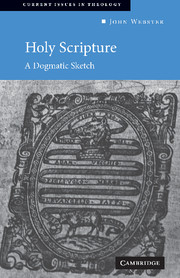2 - Scripture, church and canon
Published online by Cambridge University Press: 05 June 2012
Summary
Holy Scripture is an element in the drama of God's redeeming and communicative self-giving. Chapter 1 explored the place of Scripture in that drama by offering dogmatic construals of three aspects of God's activity as lordly and self-presenting saviour: revelation, sanctification and inspiration. Those terms are not to be thought of as referring to essentially separate acts, but to constituent parts of the single yet complex activity through which the triune God vouchsafes his presence, overwhelming sinful ignorance and setting up the light of the knowledge of himself. This second chapter shifts the focus to another dogmatic locus out of which aspects of the nature and office of Holy Scripture are to be determined, namely the doctrine of the church as the creature of the divine Word. The chapter first offers a sketch of some of the primary dogmatic issues – the church as ‘hearing church’, as ‘spiritually visible’ and as ‘apostolic’ – and then gives a more detailed specification of the church of the Word through looking at the authority of Scripture in the church and then at the nature of the church's act of canonisation.
At the beginning of the discussion, however, it is very important to stress that, in proceeding from the doctrine of God's self-revelation to the doctrine of the church, we do not move away from the Christian doctrine of God.
- Type
- Chapter
- Information
- Holy ScriptureA Dogmatic Sketch, pp. 42 - 67Publisher: Cambridge University PressPrint publication year: 2003



